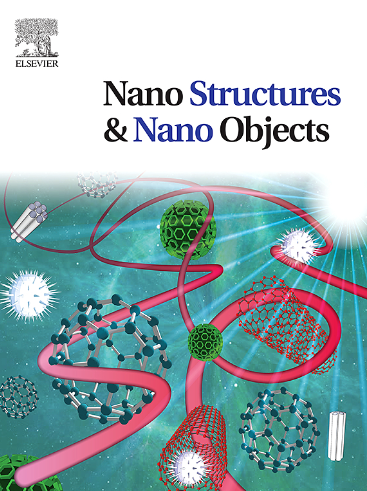Performance of TiO2-SiC nanomaterials on morphology and sorption behavior of PVA-PEG-based nanocomposites for UV-applications and antibacterial efficacy
IF 5.45
Q1 Physics and Astronomy
引用次数: 0
Abstract
This work exhibits the incorporation of TiO2-SiC nanoparticles (NPs) for the first time via a green and cost-effective route. It examines their loading into a polymeric matrix (PM) composed of polyvinyl alcohol (PVA) and polyethylene glycol (PEG) at several weight percentages (wt%) via a casting way. The Fourier transform infrared spectroscopy (FTIR) revealed the chemical properties. Field emission scanning electron microscopy (FESEM) confirmed that the surface morphology of PM is rough and homogenous. Furthermore, the insertion of lower filler loadings of TiO2-SiC NPs was uniformly and well dispersed through the PM, reducing aggregations. It is rough and homogenous. The compositional elements were achieved using EDXs. The optical absorbance values were boosted by 85 % at a wavelength of 260 nm, decreasing the indirect bandgaps by 47.5 %, from 4.58 eV to 2.40 eV (Tauc model) and from 4.83 eV to 2.60 eV (ASF model) upon SiC ratio reaching 2.5 wt%. The AC conductivity values were improved upon loading from 3.30 × 10−9 S.cm−1 to 3.52 × 10−9 S.cm−1 at 100 Hz, and the dielectric constant was higher than PM finding with maintained low dielectric loss. The strongest activity and the greatest inhibitory zone of about 24 mm Staphylococcus aureus (gram-positive) appeared at a ratio of 2.5 wt% SiC. From the results obtained, these films are promising for use in UV-blocking, energy storage, and optoelectronic applications.
二氧化钛-碳化硅纳米材料对聚乙烯醇-聚乙二醇基纳米复合材料的形貌、吸附性能及抗菌性能的影响
这项工作首次展示了二氧化钛-碳化硅纳米颗粒(NPs)通过绿色和经济有效的途径的掺入。它检查了他们的负载到聚合基质(PM)组成的聚乙烯醇(PVA)和聚乙二醇(PEG)在几个重量百分比(wt%)通过铸造的方式。傅里叶变换红外光谱(FTIR)揭示了其化学性质。场发射扫描电镜(FESEM)证实了PM的表面形貌粗糙且均匀。此外,较低填充量的TiO2-SiC NPs的插入在PM中均匀而良好地分散,减少了团聚。它粗糙而均匀。组成元素是使用edx实现的。在260 nm波长处,光吸收值提高了85 %,间接带隙减少了47.5% %,当SiC比达到2.5 wt%时,从4.58 eV减少到2.40 eV (Tauc模型),从4.83 eV减少到2.60 eV (ASF模型)。加载后的交流电导率值从3.30 × 10−9 S.cm−1提高到3.52 × 10−9 S.cm−1,在100 Hz下,介电常数高于PM发现,并保持低介电损耗。在比例为2.5 wt% SiC时,金黄色葡萄球菌(革兰氏阳性)的活性最强,抑制区最大,约为24 mm。从所获得的结果来看,这些薄膜在阻挡紫外线、储能和光电子应用方面具有很大的前景。
本文章由计算机程序翻译,如有差异,请以英文原文为准。
求助全文
约1分钟内获得全文
求助全文
来源期刊

Nano-Structures & Nano-Objects
Physics and Astronomy-Condensed Matter Physics
CiteScore
9.20
自引率
0.00%
发文量
60
审稿时长
22 days
期刊介绍:
Nano-Structures & Nano-Objects is a new journal devoted to all aspects of the synthesis and the properties of this new flourishing domain. The journal is devoted to novel architectures at the nano-level with an emphasis on new synthesis and characterization methods. The journal is focused on the objects rather than on their applications. However, the research for new applications of original nano-structures & nano-objects in various fields such as nano-electronics, energy conversion, catalysis, drug delivery and nano-medicine is also welcome. The scope of Nano-Structures & Nano-Objects involves: -Metal and alloy nanoparticles with complex nanostructures such as shape control, core-shell and dumbells -Oxide nanoparticles and nanostructures, with complex oxide/metal, oxide/surface and oxide /organic interfaces -Inorganic semi-conducting nanoparticles (quantum dots) with an emphasis on new phases, structures, shapes and complexity -Nanostructures involving molecular inorganic species such as nanoparticles of coordination compounds, molecular magnets, spin transition nanoparticles etc. or organic nano-objects, in particular for molecular electronics -Nanostructured materials such as nano-MOFs and nano-zeolites -Hetero-junctions between molecules and nano-objects, between different nano-objects & nanostructures or between nano-objects & nanostructures and surfaces -Methods of characterization specific of the nano size or adapted for the nano size such as X-ray and neutron scattering, light scattering, NMR, Raman, Plasmonics, near field microscopies, various TEM and SEM techniques, magnetic studies, etc .
 求助内容:
求助内容: 应助结果提醒方式:
应助结果提醒方式:


